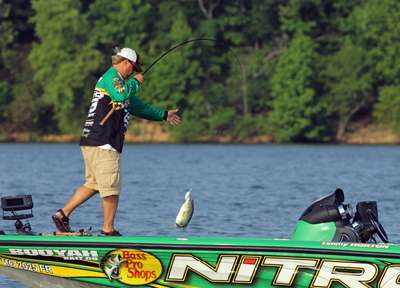
When Elite Series pros venture offshore, they do a lot more screen watching than the novice angler does to find and catch bass. “We don’t cast until we see the fish,” says Alabama pro Tim Horton. “It can really take a lot of time and effort to get on ledges and learn what to look for.”
Reading the Navionics map in his Humminbird 1197 depthfinder and having confidence in his ability to distinguish what type of fish he sees on his graph are Horton’s keys to fishing offshore structure. Countless hours of watching his graph have given Horton the expertise to interpret exactly what inhabitants are residing on the structure.
“White bass and stripers are usually off the bottom, and there will be a lot of them on the screen,” he advises. “There are always a lot more schools of those fish than bass, and they will be tighter together. A school of white bass that tops out at 15 to 18 feet will come all the way up to within a few feet of the surface.
Bass will stay down on the bottom and are going to do what I call ‘sitting up on the table.’ That’s when you can really catch them when they are not off the side of a ledge but are really sitting right up on top of the ledge. Then you will usually see 10 to 15 bumps right on the bottom.” Ledges on power-generation reservoirs are Horton’s favorite summertime offshore targets. “The number one thing I look for when I go to those lakes is water clarity because that is going to tell me how deep the baitfish are,” he says. Horton notes that on stained reservoirs such as Old Hickory or Neely Henry, the fish will hold on ledges only 8 to 12 feet deep, but bass on clearer water impoundments such as Guntersville or Toledo Bend will gather on 15- to 20-foot ledges.
Finding the sweet spot of a ledge is crucial to Horton’s offshore structure strategy. “That is really where the sonar comes into play,” he says. “I will Figure 8 a spot sometimes six or seven times until I see where the fish are located. As soon as I go over a sweet spot I put my trolling motor down, look at my prop wash and cast right back there because my transducer is right under the back of the hull. That way I know exactly where to cast because I will see the bubbles coming up from the prop wash and I know I am throwing right to where I graphed those fish.”
His favorite lures for running along shallower ledges are the Number 7 Bomber Fat Free Shad crankbait and the Bomber Tim Horton Switchback Shad in citrus shad or roux hues. “If I’m fishing a ledge that tops out at 15 feet, I want a crankbait that runs a little deeper than that,” he says. “I think it’s imperative to hit the bottom and it’s imperative as to when you hit the bottom. I don’t want to go digging on that ledge 8 to 10 feet before I get to that sweet spot. I want to get far enough back so that when I hit that ledge I hit within 3 to 5 feet of that sweet spot (to trigger a reaction strike). If your crankbait starts digging before you get to that spot, those fish are going to know something is coming into their area, but if you come right into where they are sitting and hit the bottom then you are more likely to get bit.”
For probing deeper ledges, Horton crawls a brown and black 3/4-ounce Booyah Pigskin Jig with a green pumpkin Yum Craw Papi along the bottom. Whenever the jig hangs on a rock, Horton pops the lure to mimic a scurrying crawfish.
BASS Insiders wanting to try some offshore structure fishing this summer should visit one of Horton’s top five ledge fishing destinations: (1) Kentucky Lake, (2) Toledo Bend, (3) Guntersville, (4) Eufaula (Ala.) and (5) Grand Lake. Editor’s Note: If you have a story idea you would like to vote on for an upcoming poll, send your idea to john@jnoutdoors.com.





